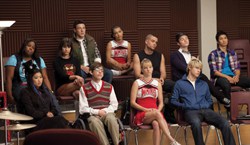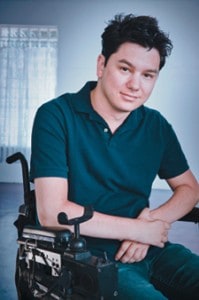
The 2011 Person of the Year is an unorthodox choice for the editorial brain trust at NEW MOBILITY. Unlike in years past, this year’s honoree is not a person of great achievement and stature in the world of disability and disability rights. He has not led the charge to enact new laws or break down historic barriers. In fact, he’s not even out of high school. A traffic accident in his mom’s car when he was 8 years old left him paralyzed from the waist down, but that has not stopped this product of Anytown, USA, from dreaming and working and living the fullest possible life of an American teenager.
This year’s Person of the Year is an extraordinary young man named Artie Abrams.
Despite his disability, or perhaps motivated by it, 16-year-old Artie Abrams excels in so many areas. At McKinley High School in Ohio, he is an active member of the school glee club, a mainstay on the Academic Decathlon Team, and even suits up and plays for the state-champion football team, the McKinley Titans. He’s easy to spot on campus: He wears thick glasses and dresses like a retro nerd. He’s a pretty skillful guitarist, writes hip-hop poetry, falls in and out of love regularly, and is not afraid to speak up when he or anyone else is wronged. He has the confidence of the faculty and staff of McKinley and was recently asked to direct the glee club’s adaption of West Side Story. He aspires to be a theatrical director and is clearly on his way.
Everything, of course, is not rosy in Artie’s adolescent life. He is sensitive about his disability and often lets that distort his view of himself and others. Friends will tell you that he has a prickly, unpredictable personality. He is sweet one minute and defensive, even nasty, the next. He’s known for sexist comments like this one once directed at a full-bosomed friend, who recalls: “Artie asked if he could make an omelet with the enormous ostrich eggs I was smuggling in my bra.” Sometimes his emerging self-confidence turns to arrogance and he pushes others away with a cynical aside. Artie is fighting two battles — being an adolescent, period, and being an adolescent with a disability. You can imagine the drama.
There is only one big problem with Artie — he is not real. He’s a fictional character on the ground-breaking Fox TV show, Glee.
Artie’s Universe
Artie is part of a fictional universe where diversity of all kinds is a given. In the glee club itself, there are pinup girls and girls with weight problems. There are blacks, whites, Asians and one Hispanic girl. There is a flamboyantly gay kid named Kurt who is harassed by bullies but beloved enough to be named the junior class prom queen. Outside the glee club, diversity also reigns. A member of the cheerleading team, the Cheerios, has Down syndrome. The football coach is a big, tough, take-no-prisoners woman. It’s a rainbow world at McKinley High and Artie is just one more screwed-up teenager trying to figure out who he is.
Artie Abrams is also the most popular and recognized character who uses a wheelchair in the history of American television. Now in its third season, Glee went from cult appeal to certifiable hit when its second season premiere drew nearly 18 million viewers worldwide. That same episode was the Fox Network’s highest-rated, scripted fall premiere among the youngest, most desirable of all demographic groups — viewers 18-49, viewers 18-34, and teenage viewers. With those kinds of primetime demos, Fox can charge more from advertisers who are desperate to get these age groups to buy their products. On Tuesdays at 8 p.m., no other show on television comes close to bringing kids and young adults to the party.
But the reach of the show surpasses just TV viewing. Glee is a music machine. Having recently hit the milestone of performing 300 musical numbers on air, the spinoff albums of these songs had sold 11 million units worldwide. Thirty-six million copies of Glee tunes have been digitally downloaded to iPods, iPhones, and all other MP3 devices. And who, overwhelmingly, downloads pop songs? It ain’t Aunt Sarah. It’s young people, starting well before they get to high school and join their own glee club.
As a way of connecting the Glee audience to their American Idol aspirations to sing and dance on TV, Glee executive producers Ryan Murphy and Dante Di Loreto created a spinoff show called The Glee Project. Aspiring amateur entrants from all over the country vie to be the one, or ones, who get to appear on the real Glee. It’s essentially a talent show that might provide Glee with another star. Meanwhile, the current stars, in their off time, perform in a concert series called Glee Live! In Concert! that played multiple dates in 2010 and 2011 from Las Vegas to Dublin. Again, who goes to pop concerts? Kids.
You get the picture: Glee is a pop-teen phenomenon, not to mention a big hit with their mothers and big sisters. And wheelchair-using, guitar-strumming, baritone-crooning Artie Abrams is right in the middle of it. To illustrate how much Artie is woven into the show, the ninth episode of season one, “Wheels,” revolves around Artie and his disability. The school can’t afford to rent an accessible bus to haul the glee club to sectional competition, meaning Artie will have to travel in a car with his mom. This doesn’t sit well with Will, the club director, so the group stages a bake sale to raise money while Artie licks his wounds. At one point, all alone on stage, he performs a solo of the Billy Idol hit, “Dancing With Myself.” Even if you think a lot of the music on Glee is thin soup, you’d be hard pressed not to react to this performance, especially if you were in a chair yourself.
In a sympathetic nod to Artie, the episode closes with every Gleester in a chair doing a choreographed performance of John Fogerty’s “Proud Mary.” Twisting and turning up and down ramps, none of the performers ever leaves their chair during the number. Again, nothing like this has ever been seen on a primetime drama. There are groups of real wheelchair users who regularly perform dance routines, pop and classic, but never in front of 7.35 million American TV viewers, along with 3.5 million others in Canada and the UK.
But Glee is just a TV show, right? Artie is not a real-life paragon of disability like Christopher Reeve, Michael J. Fox, or Stephen Hawking. He’s a passing fancy, a primetime distraction, easily forgotten in the wake of the next teenage fad. Which isn’t to say that fictional characters can’t have a profound influence. Willy Loman is just a made-up salesman. Tom Joad of The Grapes of Wrathis fictional too, but everyone who reads about the Dust Bowl days of the 1930s has Tom Joad in their head the whole time.

As far as TV’s ability to change public behavior, one quick example. In 1988 a Harvard doctor had a whole new concept: the designated driver. He went to Hollywood, asked some major producers to introduce the name and idea in their TV shows, and a year later, Gallup found that 67 percent of adults recognized the term.
Artie is a long way from an American icon like Willy Loman, but it’s not hard to picture his effect on young people in the audience who are wheelchair users, or disabled in any way. Imagine being a 15-year-old kid in a chair in Edina, Minn., probably painfully self-conscious and confused, and flipping on the TV and seeing Artie cavort around. If it’s just a hundred disabled kids who feel this identification, Glee will have had more real cultural impact than a thousand episodes of Jersey Shore or Two and a Half Men. If 10,000 such kids get the message, there’s going to be a generation of adolescent wheelchair users rolling proud and dreaming big dreams.
Artie: Epitome of Discrimination?
Critics have generally praised Glee, and raved about the “Wheels” episode, spotting a deeper level of storytelling. But the disability community, especially the community of performers with disabilities in Hollywood, were not so, ah, gleeful. The reason: Kevin McHale, the actor who plays Artie, is not a wheelchair user. He just plays one on TV. For any struggling actor with a disability, to see the most prominent role of a character with a disability in TV history being played by a nondisabled person is like a shot through the heart. From the actors’ POV, it’s like asking whether the public would stand, in this day and age, for a black character to be played by a white person in blackface. The answer is, of course not. That would be blatantly discriminatory. And Artie isn’t?
Soon after the show hit the air, the producers and casting agents of Glee were on the defensive. Bloggers called the casting of McHale a crime and episodes like “Wheels” offensive, appropriative, and wildly inaccurate. The showmakers were being accosted at Hollywood cocktail parties about their cruel insensitivity. Artie became a touchstone for the whole issue of whether actors without disabilities should ever be cast in the roles of characters with disabilities. Would Children of a Lesser God have had the same profound impact if Marlee Matlin wasn’t really deaf? On the other hand, is there an actor with cerebral palsy who could have made the character in My Left Foot more authentic or heartfelt than the Academy Award winning performance of Daniel Day-Lewis?
Setting aside these thorny questions, let’s return to Artie and how Kevin McHale actually got the role. In an interview with Robert Ulrich, one of the principal casting agents for Glee, he explained that he initially looked for actors in chairs to audition for the role, but none were submitted through the normal industry channels — which means, with few exceptions, talent agents whose entire life is dedicated to submitting actors for roles. He took an extra step and contacted the Media Access Office, a service funded by the state of California with the express mission of connecting people with disabilities with employment in film and TV. The MAO office submitted one such actor, Toby Forrest, a performer and musician, coincidentally featured in the June 2010 issue of NEW MOBILITY. Forrest tried out and by Ulrich’s and his own admission, was too old for the part. So they ended up casting an experienced musical comedy talent in McHale.
For a lot of disability activists, this wasn’t enough. From their perspective, the Glee people didn’t try hard enough to do what was fundamentally right — keep looking until they found the perfect young actor with a disability to nail the role. To them, “We asked around and couldn’t find anyone” is a cheap dodge, a way of saying, “See, we tried” — thus abdicating the responsibility to the vicissitudes of show business. As one actor with a disability blogged, “There are talented actors with disabilities out there. If they can’t be found, I’d say you’re looking in the wrong places.”
Think about it. If the highly lauded cable drama, Breaking Bad, could find RJ Mitte, an unknown, untested actor with cerebral palsy from Lafayette, La., to play Walter White Jr., a character with CP, certainly the collective powers of the casting agency, the Glee producers, and the mighty Fox Network could find a bright-eyed kid in a chair who could act, sing and look good in suspenders and a bow tie.
In a perfect world, probably so. But Hollywood, no matter what Mario Lopez tells you on Access Hollywood, is not a perfect world. It is an extremely high-pressure, high-risk, get-it-done-yesterday-or-we’ll-find-someone-else world. Especially in television, where the stuff is thought up and cranked out at warp speed. As Ulrich explains, “In my defense, we were trying to cast an entire show — at least 12 main characters — in a short time and no one but Toby was submitted. I’ll take responsibility that I wasn’t that aware three years ago. Hopefully, because of Glee, it might be easier next time.”
Or not. For example, due to the huge outpouring of love for the show, the Oxygen network ordered up the aforementioned series, The Glee Project. What naive, born-entertainer of a teenager wouldn’t want to sign up for this Hollywood lottery? Apparently kids in chairs. “In our first season of this open call talent search,” says Ulrich, “out of 43,000 entrants, only one person in a wheelchair auditioned.” That person was headed for the round of 80 when — because of her association with Glee — she was cast in a show in New York where they didn’t even specify “wheelchair.”
The Glee Project auditions for its second season are going on as I write this. If the door is still open and you’ve always dreamed of singing, dancing, and wheeling on TV, now is your chance for a shot at the brass ring.
The Actor/Character Paradox
This whole actor-versus-character issue is fraught with paradox. If the hundreds of talented, aspiring people with disabilities can’t land roles that explicitly call for someone with a disability, how are they ever going to land roles that just call for a good actor? You know, the bartender, the lawyer in the next office, the woman down at the pharmacy? For this very reason, agents are hesitant to sign people with disabilities because of the dearth of roles available to them. Without an agent, you can’t get hired. If you don’t get hired, you don’t get seen — or paid. If you aren’t seen, you’re just another actor in Hollywood desperate for a break. A predicament like this can get very demoralizing very quickly.

Someone who understands the situation clearly is one of the most prominent people in the Hollywood disability community, actor Robert David Hall. You might know him as Dr. Al Robins, the chief coroner on the mega-hit, CSI, for the last 12 years. After becoming a double amputee from a horrendous traffic accident in 1978, Hall worked his way up from the bottom. He did radio voiceover work to pay the rent, then got an occasional inspiring and/or pathetic cripple role, then grew a beard and became the go-to guy for the scowling judge in every courtroom drama on TV, and finally caught his big break with CSI. He feels the plight of the person with a disability deeply. He’s been there.
“It’s pure mathematics,” Hall says. “You have to have the requisite number of auditions [a zillion] to have a career.” You can’t hit the ball if you’re never up at the plate. If you can’t fashion a career, you become a hobbyist, if you can afford it. “And,” Hall goes on, “even if you get seen, the fates have to be in your corner. We are not a smart business, you know, like plumbing or auto repair. You rarely get steady work even if you are talented and driven.”
The Media Access Office, mentioned earlier, has been trying to be the non-profit agency, or clearinghouse, for actors with disabilities since 1979. In the 1980s the state of California began to fund it as an employment development program; then came “The Great Recession” and the staff was reduced from four to exactly one, current director Gloria Castaneda. One person, meager budget: That doesn’t leave a lot of money or time for marketing, industry awareness or even a website. According to Castaneda, the calls are pretty constant, at least for one-shot parts and from producers or others who know of the office’s existence. The MAO has 900 people with disabilities on file, more than half of whom are background players. Castaneda says she has seen an increase in calls in the last year or so, but she only has so much time to really promote her clients. And in Hollywood, promotion is the lingua franca of success.
If you are an actor with Down syndrome looking for work, you have another insider in your corner. Gail Williamson, executive director of the Down Syndrome Association of Los Angeles and herself the mother of a child with Down syndrome, is fanatical about getting actors with Down syndrome on shows. If a casting director calls Gail about a Down syndrome role, he or she will have 10 candidates beating down their door in a matter of hours. Case in point: the role of Becky Jackson on Glee, a character with Down syndrome played by Lauren Potter. There’s a bit of an advantage here. “If you have a character with Down syndrome,” Williamson says, “you pretty much have to use an actor with Down syndrome.” She reads pilot scripts, spots the mistakes in any scripting of someone with Down syndrome — which producers love and appreciate — and has her candidates for roles trained and available. Like the savviest of Hollywood agents, in Robert David Hall’s words, “Gail Williamson makes things happen.”
Artie: Phenomenon of One
Fair or unfair, Kevin McHale got the Artie part and has had his share of storylines. Artie falls for a girl named Tina because he thinks she has a disability, too — stuttering. When he finds out she is lying, he dumps her and after much sturm und drang, he has sex, for the first time, with another girl, Brittany, who has a nonchalant attitude toward such things, which irritates Artie to no end. As mentioned earlier, in a huge stretch of credulity, Artie makes the football team and scores a big touchdown by becoming a human battering ram. Even hardcore fans on “Gleeforum” didn’t buy this gambit; as one posted, “This is a major FAIL as far as I’m concerned … [it’s like] a blind person applying to be a driving instructor.”
In season two, Artie even has a dream sequence in which he gets out of the chair and leads an exuberate flash mob dance number in the mall. You can hate this kind of double-edged fantasy, or you can love it, but the whole thing couldn’t have happened unless the actor could walk.
Perhaps the made-up Artie Abrams is NEW MOBILITY’S Person of the Year because his constant, week-after-week presence on television is a milestone, however flawed, signifying that we have come a long way since the groundbreaking primetime performance of Geri Jewell as Cousin Geri on Norman Lear’s The Facts of Life in the early 1980s. “Images and stories change things,” Hall contends. The portrayer of Artie isn’t paralyzed, but the image and story of Artie, the goofy, multidimensional wheelchair user, are now part of American pop culture.
And one more thing: Artie isn’t the only character with a disability to show up on Glee, but he is the only such performer who isn’t really disabled. According to Robert Ulrich, this is not any quid pro quo because of the Artie dust-up; it’s because creator Ryan Murphy writes such roles, first in the cable series, Nip/Tuck, and now here. In that breakout Artie episode in season one, we’re also introduced to the character with Down syndrome mentioned above, Becky Jackson, who soon becomes “secretary” and cheerleading co-captain for the dyspeptic Sue Sylvester. A young actor in a wheelchair, Zack Weinstein, was spotted by Ulrich and cast as a guest star (see sidebar). And in an episode called “Hairography,” a rival choir from the Haverford School of the Deaf appears and sings/signs their heart out. As Ulrich is quick to point out, every member of this group is either deaf or hard of hearing. For these efforts at inclusion, Ulrich’s company was the recipient of the Casting Society’s 2010 Media Access Award.
Robert David Hall sums it up nicely: “Glee has probably hired more actors with disabilities than any other TV show in recent memory. It’s an irony, given the whole Artie controversy, but it’s a fact.”
However, Glee, even when seen in the most favorable light possible, can’t alone save the day and open the doors of Hollywood to actors with disabilities. Artie is not a nerdy, jive-talking Moses leading his peeps out of the wilderness. Hopefully, the show can help a little. Because of Glee, perhaps seeing characters with disabilities in the middle of primetime will be a little less foreign, to both audiences and casting directors alike. But until the much bigger structural problem is solved — the few options for people with disabilities to find representation, gain exposure and chops, and build a career — the frustrating struggle will continue.
“The one thing you can’t do,” Hall says “is walk away from the table. This is not a battle easily won. People like to use the cliché, ‘this is not a sprint, it’s a marathon.’ Well, in this case, it’s more than that. It’s an ultra-marathon.”
Zack Weinstein and the Hollywood ShuffleThere is a whole new generation of performers with disabilities who have pulled into Hollywood in the last few years, and they arrive with certain advantages. First of all, they are young and fresh; the “industry” rarely grooms new stars from 40-year-olds. They are also savvy from years of media input and unburdened with repeated failure. One of this new breed is Zack Weinstein, a 20-something with a shock of black hair and a C4-6 spinal cord injury from a canoe accident. Weinstein’s most notable role to date is a guest shot on Glee. Maybe you saw the episode. He played a guy with C4-6 paralysis. Weinstein arrived in Hollywood knowing no one in the business. He found an agency online open to actors with disabilities, rolled into their office, and pitched his talents. Waiting for a call, he landed a commercial through a non-union service called LA Casting. The commercial was a Screen Actors Guild shoot so now he needed an agent to make a deal. Back to KSR, the agency he had already pestered; they signed him right up. Weinstein arrived in Hollywood knowing no one in the business. He found an agency online open to actors with disabilities, rolled into their office, and pitched his talents. Waiting for a call, he landed a commercial through a non-union service called LA Casting. The commercial was a Screen Actors Guild shoot so now he needed an agent to make a deal. Back to KSR, the agency he had already pestered; they signed him right up.
He has nothing but nice things to say about the Glee experience. He played Sean, a former football player who realizes that he has other talents than sports, namely math. And because it’s Glee, Sean (and Rachel) sing a closing duet of U2’s “One.” In depicting a wheelchair user, Weinstein says, “They [the producers] had it extremely accurate.” After a guest shot on NCIS and a lot of sitting around, Weinstein is now up for a role as a series regular on a new show on CMT. His competition? Five other guys in wheelchairs. That’s got to be a hopeful sign for the disability youth movement. |
Support New MobilityWait! Before you wander off to other parts of the internet, please consider supporting New Mobility. For more than three decades, New Mobility has published groundbreaking content for active wheelchair users. We share practical advice from wheelchair users across the country, review life-changing technology and demand equity in healthcare, travel and all facets of life. But none of this is cheap, easy or profitable. Your support helps us give wheelchair users the resources to build a fulfilling life. |


Recent Comments
DINOS PITSILLIDES on Functional Fitness: How To Make Your Transfers Easier
Stosh on Functional Fitness: How To Make Your Transfers Easier
Bill on LapStacker Relaunches Wheelchair Carrying System